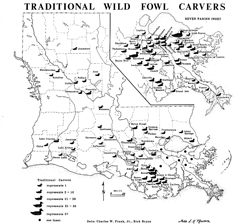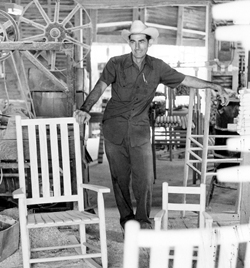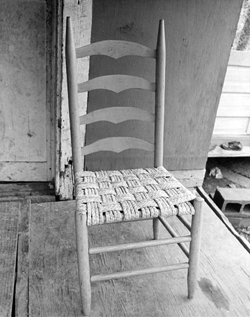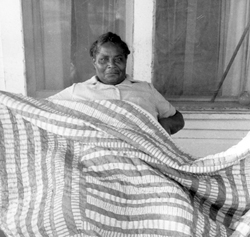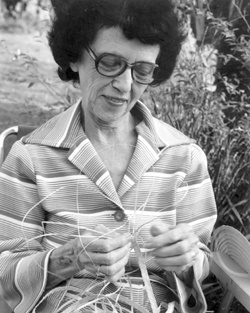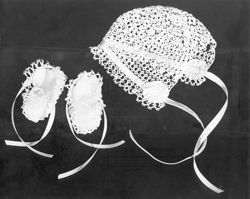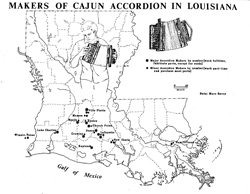Table of Contents
Louisiana Folklife: An Introduction
Folklife Research in Louisiana
Ethnicity, Region, Occupation and Family
Living On and Off the Land in Louisiana
Documenting Tradition
Folklife and Public Policy
Appendices

Louisiana Folk Crafts: An Overview
By Rosan A. Jordan, F. A. de Caro, Susan Roach-Lankford, and Nicholas R. Spitzer
This essay originally appeared in Folklife in Louisiana: A Guide to the State published by the Office of Cultural Development in 1985. This essay is provided online courtesy of the editor since the publication is out of print.
Introduction
In the folklife context the term crafts refers both to processes (e.g., basket making) and products made through those processes (baskets). Crafts (in the product sense) are utilitarian items fashioned for use in the daily or annual round of work activity (baskets may be used for storing cotton), or for use in carrying on everyday life in an efficient and satisfactory manner (e.g., clothing and bed coverings). Although the crafts item may have an aesthetic dimension, the utilitarian aspect is predominant (when the aesthetic element predominates we have folk art), However, when the crafts product is used in a ritual contest (such as grave wreaths), or to create some art form (e.g.. traditional musical instruments), the dividing line between folk crafts and folk art is a fine one. Folklife activities such as hunting or trapping, where no artifact is produced by the activity, are not generally referred to as crafts. However, the making of an item for use in such products as fishnet, bird trap or blowgun would be a craft.
Folk crafts are both products of a physical and social "landscape" and a response to that landscape. The materials used in a folk craft are traditionally taken from those available in the local environment (for example, split cane for Louisiana baskets). The physical environment to some extent also shapes the need for particular crafts (for example, boat building in a land of diverse water environments such as swamps, rivers, marshes, and bayous), but the social environment works to define what crafts are needed and how that particular need should be satisfied. Even when the same needs for crafts products exist in many societies, the crafts which have evolved to satisfy those needs may differ considerably in form and in terms of the making process followed.
The folk craftsperson may be a specialist, or the craft may be practiced by virtually everyone in the community (though the former situation is increasingly the norm). The folk craftsperson learns his or her craft through a folk process by which methods and techniques are passed down informally in families and communities over generations, not through books or in formal classes. Folk crafts exist, then, in the context of communities where traditional ways of life are carried on, and the crafts are made to suit local needs and according to the standards of taste of the community (however, outside influences may be a factor; in recent years folk crafts have often been sold to collectors or as souvenir items, a development that has had an impact on both form and process).
Although Louisiana folk crafts have by no means been researched or documented very fully, there has been an active crafts tradition in the state. The following is meant to provide an overview of some of these crafts and some representative craftspersons. (Boatbuilding and folk housing are dealt with later in this section in articles by Comeaux, Newton and Gregory. Indian crafts and occupational craft traditions as well as crafts in north and south Louisiana are covered in part in articles in the preceding section by Gregory, Stokes, Roach-Lankford, and Spitzer).
Hunting and Fishing Implements: Decoys and Nets
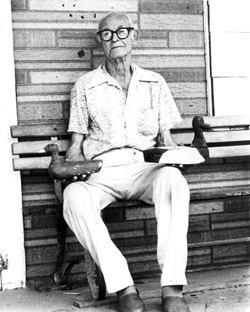
Hunting and fishing are very important subsistence activities in many folk societies, and in Louisiana these activities continue to be widely practiced, both as occupations (often in a modern, commercialized version) and as sport. Traditionally, folk artifacts associated with these activities have been made.
Because of their aesthetic appeal, bird decoys, like quilts, have received considerable attention and appreciation from the general public. Made to attract flying wild fowl, the use of decoys in North America can be traced to pre-Columbian times. Decoy carving has flourished along the Atlantic seaboard, but for years commentators on decoy carving seemed largely unaware of the existence of such a tradition in Louisiana. It was thought that the decoy carving tradition remained strong down the coast as far south as North Carolina, and then weakened further south and around into the Gulf. As late as 1965, William Mackey wrote that "the great region lying...along the Gulf of Mexico has never gone in for decoy-making," adding that the decoys used in this region were supplied by northern factories (Frank 1975:25). In 1976, however, in the catalogue of a major exhibition of hand-carved decoys, Paul A. Johnsgard noted that the carving tradition did indeed pick up again in Louisiana, though the exhibition in question did not actually include any Louisiana examples, because "only very recently have the details of the Louisiana decoy-carving history been established" (Johnsgard 1976:22). These details had been documented by Charles Frank, whose book on the subject was published in 1975.
Frank's list of carvers includes several who were working in the nineteenth century, such as Edgar Danton of Raceland, "Baba" Palas of Buras, and Ezave Ragas of Bechel. But the craft particularly flourished in the years 1915-1935, especially in Lafourche and Terrebonne Parishes; the Depression may even have stimulated production during the last of those years as the carvers turned to the decoys as a source of income and as a way to fill time in a period of low employment. Commercial market hunters also made use of large numbers of decoys in earlier times. Of course, decoys continued to be made after 1935 and, if anything, the craft has seen a renaissance in the last decade. There has been a decided shift, however, away from the decoy as a working craft and in the direction of its being seen as an art form. Working decoys are still made, but many hunters have shifted to the use of decoys mass-manufactured of modern, synthetic materials, and the hand carved birds have become more and more collectors' items made for display. The change in decoy making has thus been from subsistence to sport and art. As New Orleans Creole carver Charles Hutchison has commented, "In the old days we used to catch birds with decoys, nowadays we mostly catch men" (personal communication 1981). Today there are several organizations in the state for carvers that plan shows and confer awards. Most notable among these for their great diversity of members from folk to fine-art carvers is the Louisiana Wildfowl Carvers and Collector's Guild. Organizations such as these have been the trend in other parts of the country as well (Chittenden and Parsons 1980:45).
Traditionally, Louisiana decoys were fashioned out of various materials: cypress roots, tupelo gum, and willow, or, at a more primitive level, simply of mud or Spanish moss with stick or straw heads attached. Earlier craftsmen were often trappers, market hunters and guides by profession and might also have carved paddles and made dugout pirogues. As elsewhere, the craft has been primarily a male craft, though some women have been carvers or painters. In some cases the tradition has been passed down in families; the Whipples of Bourg, for example, count well over twenty carvers in the family ranks (Frank 1975).
Based on data about contemporary wildfowl carvers in Louisiana supplied primarily by Charles Frank, a unique map has been made for this volume to show the location of carvers currently known (Map). Clearly the many water environments of south Louisiana dominate the picture and should once and for all show the vibrancy of the tradition on this part of the Gulf Coast. Additional information from Rich Byran, which shows some carving tradition in north Louisiana, especially near such a major waterfowl refuge as the Catahoula Lake area north of Pineville, has also been added.
Given Louisiana's watery environment, net making has been and still is a craft of some importance, and there are net makers in various parts of the state, from rural areas like Bayou Grand Caillou south of Houma to urban areas like New Orleans. In the Atchafalaya Basin a great many handmade, tar-dipped nets are used, and the recent influx into the state of Vietnamese immigrants seems to have brought also an Asian net making tradition to Gulf Coast Louisiana. Perhaps ironically, the best documented traditions are not those of the coast but rather those associated with the inland fisheries in the northeastern part of the state, where freshwater commercial fishing developed in the early part of this century, and those associated with the Atchafalaya Basin. At one time in the northeastern Delta region large seines were used to catch the fish, but that method has declined since the 1950s. Today smaller hoop nets and "catfish" nets are mainly used. These nets are made in sections, knitted out of cotton twine, which is then hung over hoops made of wood (white oak); inside, tapered "flues," also knitted, are hung to create a kind of trap. Today, the netting may be made of nylon string, and the hoops of metal or fiberglass. The extent of the art of net making in north and central Louisiana has declined, but such craftswomen as Ellen Trichell and her daughter, Mildred Monroe, of Trichell Community in Natchitoches Parish, both wives of fishermen, continue to make nets there (women have often been the net makers in this area, though men make them also (Gregory 1966:17-26; Gregory, Green, and Raymond 1981:16, 44). Seines and hoop nets have also been used in the Atchafalaya and are similar in construction to those already discussed. Again, they are often made by women (Comeaux 1972:50-51, 55-58). Crab traps made of heavy gauge wire and frog nets are also made locally within the state (Comeaux 1972:74, 77). Furthermore, catfish traps and live boxes made of thin pine strips are found in the Atchafalaya Basin, the Catahoula Lake area and elsewhere in freshwater fishing locations.
Building Crafts: Tools and Trades
The creation of entire buildings (i.e., houses) within a folk aesthetic does not generally occur today. However, certain crafts associated with folk buildings, such as those described by Newton later in this section, may be found. Building in wood requires the ability to hew and notch logs in a variety of patterns such as "dove tail", "half dove tail" and "saddle." Although some traditional woodworkers have these skills, few put them into practice anymore except as a demonstration in a museum or folk festival setting. There are exceptions, however, such as Herman Davis, a woodworker from Florein who is constructing a log structure for a smokehouse as this is written. A number of persons in the Cane River Creole settlement are reputed to be able to mix and repair bousillage utilized in walls and chimneys of Creole half-timbered houses. Perhaps a larger number of persons statewide continue to rive wood by hand into shingles. Craftsmen have demonstrated this practice at festivals in north and south Louisiana, and many still make repairs of shingle siding or roofing with rived "shakes," as the cuttings are called.
Some traditional craft practices revolve around decorative items within or on buildings such as ornamental ironwork, wood molding and plaster ceiling medallions. Though many of such works, found especially in New Orleans, are for structures that are within an elite rather than folk tradition of construction, the trades of ironworkers, wood carvers and plasterers definitely have folk elements in terms of how the crafts processes are transmitted, often within families, such as the father and son team of Albert and Thomas Lachin, who are third and fourth generation architectural plasterers (Tobar-Blanco, Perry Harker and Panquerne 1978). Creoles of color have often dominated these craft specialties and are particularly associated with the ironwork found throughout the Crescent City (Christian 1972).
In recent years blacksmiths, who are associated with more utilitarian functions, have become involved in decorative ironwork. However, unlike other earlier metal craftsmen, blacksmiths do not seem to show a unified folk aesthetic in the newer ornamental ironwork found to date. Blacksmiths do continue to make a variety of tools and craft-related items. The late Saul Guidroz of Carencro (1899-1981), whose blacksmith shop was photographed and documented in 1975 as part of Smithsonian Folklife Program field research, did everything from making horseshoes, buggy-wheel frames and triangles for Cajun music to fashioning tools for agriculture and oilfield work. Rayule Breaux, also a Cajun blacksmith, continues to make a variety of farm and garden implements in his shop just west of Lafayette. A number of other traditional blacksmiths still work in the state, and they are not limited by any means to French Louisiana. For example, Leroy Wilkinson of Montpelier is a third-generation blacksmith in his Anglo-American St. Helena Parish family (Workman 1982).
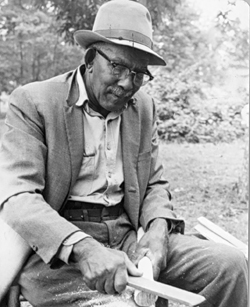
Although blacksmiths may have made and continue to make the metal portions of tools, there are many items which require wooden handles. While most people today acquire factory-made handles at hardware stores, a number of woodworkers make tool handles throughout the state. Such handles as those of N. W. Webb of Hornbeck are generally thought of by users to be superior to mass-produced items, since they are specially fitted to individual tools. Webb's handles of white oak are primarily for axes and hammers and sell as fast as he can make them (Gregory, Green and Raymond 1981:10, 43). The work of a black handle maker, E. L. Smith of Vixen, Caldwell Parish, is not unlike that of Webb, demonstrating that utility rather than cultural preference or style dictates the form of such items.
The formalization of certain crafts into trades could be the subject of an entire essay and the reader is referred to portions of George Stokes's commentary on occupational folklife in the previous section. Those interested in craft skills and products surrounding boat building in Louisiana should consult the essay by Malcolm Comeaux later in this section.
Furniture
Furniture made according to folk processes by rural dwellers for their own use or that of their neighbors (sometimes called "country furniture") has been a staple of the American cultural landscape for hundreds of years. Though mass-manufactured furniture has become the norm, some folk furniture makers continue to ply their craft in Louisiana as elsewhere. Geographer Lauren C. Post gathered information on Acadian chair making prior to the 1930s during his Louisiana research in the middle and late thirties and published a brief account of it in his Cajun Sketches (Post 1962:98-99). These "Creole chairs," as they were often called, had straight backs and cowhide seats, with the hair still remaining on the hide. Ash, hickory and red gum were used in their construction, which involved the use of various tools, including a food-powered lathe. One chair-maker, "old Aladdin," built his chairs during the summer and in the fall became an itinerant seller of his wares, travelling across the prairies in a wagon, selling the chairs for a dollar apiece.
Aladdin stopped making chairs in 1910, and Post suggests that the tradition died out in the 1930s, but in fact folk chairs are still being made in Acadiana, including some with rawhide bottoms in Oberlin and Duson. Other types are more common today, such as those of D. L. Menard, whose workshop occupies a spacious metal building in Erath, Vermilion Parish, and who makes several types of furniture, including rockers and ladder backs within a Lower Mississippi Valley style.
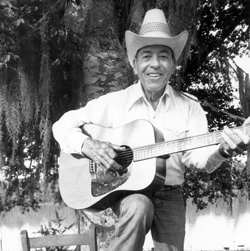
Rawhide-bottomed chairs were by no means limited to French Louisiana (and are in fact found in various parts of the United States) and in north Louisiana Herman Davis of Florien continues to make chairs with the hide seats. A former construction worker who decided to try another trade and bought out a woodworking shop, Davis learned the craft from the elderly man he bought out. He mills his own lumber, and the tools he uses, also handed over by his predecessor, are over seventy-five years old (Gregory, Green and Raymond 1981:9). A recent exhibition of north Louisiana folk crafts at the Alexandria Museum-Visual Arts Center included examples of bent willow and hickory furniture by an itinerant Arkansas craftsman who does sell his ware in north Louisiana (Gregory, Green and Raymond 1981:35), but this type of furniture has been made by residents as well. However, it seems less a regional tradition than a folk approach to the mass-produced styles of earlier eras.
Baskets
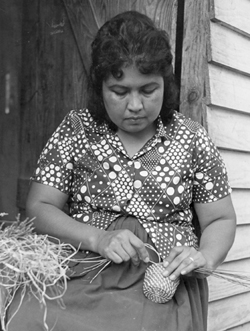
Louisiana Indians make a variety of baskets. Chitimacha double-weave baskets are among the most famous in North America, and Coushatta coiled baskets have found particular favor with collectors also (see essay on Indians by Gregory in previous section). However, Indian and Indian-style baskets are by no means the only ones being made in the state today. There is also a strong tradition of split white oak basket making practiced by both blacks had whites (and by at least one Coushatta). V. L. Westbrook of Ruston, who died in 1980, was one prolific north Louisiana maker. Rev. Westbrook was a retired Methodist minister, whose father and grandfather made such baskets, too. Born in Sabine Parish, he tried to make a few baskets as a child, lost interest in the art, and then came back to it about ten years ago at a time when his work load as a minister had begun to lighten. After difficult beginnings he mastered the craft and made 3,900 baskets before his death, according to records which he kept. He and his wife would gather the raw materials by sawing down small white oaks (four to five inches in diameter). He maintained a small workshop, and here he stripped and soaked the wood and wove the half-inch or three quarter-inch strips into baskets (using a form around which he shaped them, an innovation of his own). It took him several hours to weave a basket. All of his baskets are round and range in size from four to twelve inches in height and from three to eleven inches in width. He sold most of them directly from his home to customers who heard about his work, but he also participated in festivals and fairs where he demonstrated his craft.
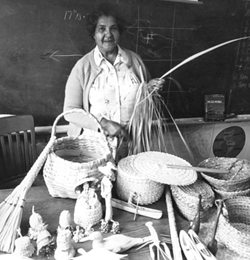
The round shape of Westbrook's baskets was probably dictated by his unique use of the central form, but Louisiana split oak baskets are made in a greater variety of shapes by other craftsmen. Jack Phillips, an Alabama native who now lives in Shreveport, fashions split oak baskets in many shapes and sizes: round, tapering laundry baskets: oblong egg baskets; low, rectangular flower baskets; and deep clothes baskets with tops, among others. Called the maker of "some of the finest white oak baskets in the South" (Gregory, Green and Raymond 1981:15), Phillips is a former trader and leather worker who turned to basketry when disabled and unable to work (indeed, forced or voluntary retirement as a factor leading to the taking up of a traditional craft seems to be a fairly common pattern among contemporary craftsmen; crafts have perhaps become more of a "leisure time" activity than when they were a more integral part of daily economic activity). Part of Phillips's technique in basket making was learned from Afro-American basket maker Fred Henderson of Alabama, who taught him how to split the white-oak strips, rather than whittle them. Phillips also traces his knowledge of basket making to the Cherokee tradition in Alabama (he is one-eighth Cherokee, but did not grow up in an Indian cultural tradition) and to observing Cherokee craftspersons. However, the form, style, and function of his baskets seem to be related largely to Anglo-American basketry.
Among Afro-American basket makers, the late Thonius Robertson of Washington, in St. Landry Parish, was probably the best known and had appeared at various fairs and festivals including the Smithsonian Folklife Festival (Tobar-Blanco, Perry, Barker and Panquerne 1978:20). Another man who carries on in this tradition is Edward Harris of nearby Nuba. He and his seven sons all make split oak baskets for a variety of uses. The utility and function of both Robertson's and Harris's baskets is demonstrated by the fact that they are sold in local hardware stores in nearby Opelousas.
Corn Shuck Weaving
One sees in Louisiana crafts both fidelity to the continuity of tradition and changes which have been made to meet the demands of changing times or, of course, to allow a degree of individual ex-pression. The corn shuck plaiting practiced by Willie Mae Young, of Polk Community near Jackson, offers an excellent illustration of this balance between continuity and change. Mrs. Young learned her craft from her parents. She makes out of shucks a sturdy variety of floor mats such as her mother made (Mrs. Young remembers these as welcome on cold mornings), but she does not use any in her own home. Her father used the plaited shucks to make chair bottoms and horse collars, and she continues the tradition of weaving bottoms for chairs, for her own family and for others. However, there is no present demand for corn shuck horse collars, and Mrs. Young has never made one. She does make one item which her father and mother never did-placemats, the idea for which she conceived on her own to appeal to a contemporary market. She has sold these placemats and floor mats through Shadetree, an antiques and gifts shop in St. Francisville. She has also experimented with nontraditional materials, once fashioning a placemat of jute which she purchased at a local crafts supply store (friends and neighbors give her corn shucks). She was not particularly happy with the jute mat: though she liked working with the new material, she preferred the traditional natural color of the corn and may in the future try again if she can locate jute which is closer to the traditional color.
The making of utilitarian items from corn shucks has been a flourishing craft in West Feliciana Parish in the recent past, and, indeed, cornshucks in crafts have been widespread throughout the United States. For example, shucks were a common chair-seating material in the nineteenth century. Another practitioner of the art, Willie London, is married to a cousin of Mrs. Young; his wife recalls that various other people, including other family members, used to work with shucks. And Mr. London, who at one time bought and used horse collars made by Mrs. Young's father, notes that he knows people who claim to know how to weave shucks, though they do not actually do so. He himself learned to make bags from shucks as a child in "the west parish" (he now lives in Ethel in East Feliciana), and as a young father he decided, after some years of not making bags, to construct one to hold his first child's things when the family went to church. Eventually he made a "diaper bag" for each of his ten children. Later, again after some years of not making bags, he turned to bag making as a source of income. He has also made changes within the tradition he learned, apparently moving from relatively tightly woven bags to more loosely woven bags somewhat resembling string bags. Today many of the bags he makes are designed as women's purses and follow a stylish pattern with a long top which folds over the opening of the bag and which can be fastened closed. The objects which Mr. London uses for fasteners, however, are unique and varied and certainly serve to distinguish his purses from the store-bought variety: he has used Mardi Gras doubloons and tin cut from a beer can, among other devices. He also makes for men smaller, narrow bags which fit into a pocket. Like Mrs. Young, Mr. London has appeared at the New Orleans Jazz and Heritage Festival, and it is there that he sells most of the bags that he makes, a factor which has probably affected the kinds of bags he currently prefers to make.
It is interesting to note that three quite different techniques of working shucks have been used by living craftspeople from West Feliciana Parish. Willie Mae Young plaits (braids) the shucks, which are first steamed to make them slightly moist, using three strands which are first tied in a knot. As she proceeds she works in more shucks to create a long braid. To make a mat she coils the braid around and around and sews the coils together. For a chair bottom, the end of the braid is first looped around the back rung of the seat and sewn in a loop to hold it fast; then it is run back and forth between the back and front rungs to cover the opening; next it is looped around and woven between the strands running front to back; and finally the second end of the braid is looped around the rung and sewn. For sewing Mrs. Young uses a huge needle that her father used mostly for sew-ing sacks in the cane fields. Willie London does not sew any part of his bags, nor does he braid the shucks (which he selects carefully for strength and moistens in a pan containing a small amount of cold water). He works with two strands and twists them tightly together into a sort of twine, tied at one end and kept very taut. When he wishes to actually begin on a bag he ties the second end of the twine, which would otherwise unravel. To fashion the bag he uses a wooden frame, which might be a single piece of wood or several nailed together. The twined shucks are wound twice around the frame at one end; then Mr. London begins the process which he terms "plaiting," looping the twine to make a series of interlocking half-hitch-knots. Handles are done separately and woven in. Twisting the shucks is hard on his hands, and although Mr. London has considered trying some softer, commercially manufactured material for his bags, he has not yet done so. He has been amus-ed by the surprise expressed by visitors to the Jazz and Heritage Festival that anything at all can be made out of corn shucks.
A third technique was used by Lucinda Ruth, who in fact no longer makes anything out of shucks at this time. Mrs. Ruth, who learned the art as a child in Cat Island, twisted her shucks somewhat in the manner of Willie London, but to fashion the mat, she sewed the resulting strands together with cotton thread. The LSU Museum of Rural Life has in its collection a mule collar of corn shucks which dates from around 1910, but we know of no one in Louisiana who still makes such collars out of shucks (though there may well be someone, and a recent museum exhibition catalogue [Black et al. 1980:24] shows a picture of Abraham Hunter of Wilkinson County, Mississippi, which is adjacent to West Feliciana Parish, making a mule collar). The Louisiana Traditional Crafts exhibition at LSU in 1980 included a basket made by Susan Lavinia White Anderson in 1909. Though the basket was actually fashioned in Mississippi, Mrs. Anderson lived in Louisiana and came from a family which was spread throughout the Felicianas as well as the adjacent counties of Mississippi. Although Mrs. Anderson apparently never made other baskets, her family regularly made a great many useful items out of shucks, according to her descendants (de Caro and Jordan 1980). The use of shucks in West Feliciana Parish, once common to blacks and whites, seems to continue today only in Afro-American tradition.
Quilting
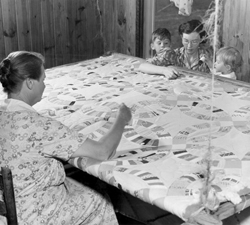
The term quilting refers to the sewing together of two or more layers of fabric to provide greater strength or warmth. Quilted materials have been used for a variety of purposes (for clothing, rugs, hangings), but in American folk crafts the term quilt means a bed covering made of two, or more usually three, materials sewn together. Generally, a quilt is made of a top (either pieced, appliquéd, or plain), a middle layer of filler ("batting"), and a back (or "lining"). Colonists brought quilt making to America, and the multitude of patchwork patterns which gradually developed followed and changed with the migration of the settlers. Early American quilts were predominantly utilitarian, necessary for bed covers, and were pieced often haphazardly from worn clothes and fabric scraps left from sewing. Quilting, the stitching that holds the layers together and keeps the batting in place, was probably hurriedly done in the early settlers' quilts. As economic situations eased and leisure time and fabric became more plentiful, quilts became more complex with intricate piecing and quilting designs. In these "fancy" quilts the finest needlework was demanded. By the nineteenth century, quilts had developed into a widespread American folk craft and art. Today, quilt making remains an uninterrupted folk tradition in many areas of the U.S. and has appeared among other groups, especially urban middle class, to become a popular craft, learned through formal classes and popular books.
Louisiana still has its share of traditional quilters who continue to make both "everyday" (also called "common" or "plain") quilts as well as "fancy" quilts. Although quilt making was introduced by Anglo-Americans, in Louisiana quilting is a vital tradition among Afro- as well as Anglo-Americans and is said to include some Coushatta Indian quilters. Historically, African slaves, who were not natively familiar with quilting techniques, learned the craft as part of their plantation work. The European aesthetic of precision and complexity can be seen in surviving slave quilts and in many later Afro-American quilts such as those of Frances Sykes, of Claiborne Parish, who has pieced such difficult patterns as the "Pineapple," "Broken Star," and "New York Beauty" (see Roach-Lankford's article on north Louisiana in the previous section).
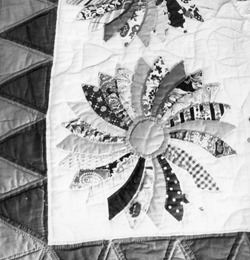
The simpler "everyday" quilts are still frequently made by both black and white women, especially in rural areas for use as bed covers to save on heating bills. Fabrics for these quilts are often from factory or sewing remnants or garage sales. Basic patterns such as the "String" quilt or the "Nine Patch" are often used in these utilitarian quilts, although more complex patterns may also be used in everyday quilts. These quilts may use an inexpensive sheet or cotton muslin for the lining and a cotton or polyester batting. Generally, quilts are quilted in traditional four-sided wooden frames which may be suspended from the ceiling or placed on chairs or "horses." The frames allow the top to be stretched over the batting and lining so that all three layers can be hand-stitched (quilted) together. When there is insufficient room for the large frames in a small room, some quilters, especially in black communities, will stretch the layers over a bed to quilt it. Mary Anderson of Rapides Parish uses this technique, even though she admits that it is a problem to keep the top as smooth when it is quilted on the bed. The quilting design on utilitarian quilts is usually simple. It may be done "by the piece," which entails stitching about one-fourth an inch from the patchwork seams. Less frequently, quilting is done in "shells" or "squares" which consist of decreasing half-circles or half-squares of rows of stitching done about an inch apart.
In the past Afro-American quilters frequently made "strip" quilts for everyday use. These were constructed of scraps of cloth sewn into strips, often the length or width of a bed, and then sewn together. Although this type of quilt is also found in the Anglo tradition, it seems to have been made more frequently by black quilters. It has been suggested that these strip quilts, which have analogues in West African textiles, were the aesthetic preference of the African slaves because the basic strip design preserved a cultural memory (Vlach 1978:70, 73). Today the strip quilt seems to be losing favor with black quilters such as Charlotte Thomas, of Rapides Parish, and Rosie Lee Allen, of Claiborne Parish, who both made strip quilts when they were younger but now prefer traditional patterns such as the "Flower Garden," "Star," and "Around the World."
Generally, the makers of utilitarian quilts learned quilting from their mothers, who had to make quilts "just for cover," and many Louisiana quilters continue in this tradition. Some quilters such as Minnie Lee Graves and Opal Madden, of Lincoln Parish, and Nova Mercer, of Jackson Parish, helped their mothers make everyday quilts, but after their marriages, with the influence and help of neighbors and friends, they began to make fancier quilts such as the Louisiana favorites, the "Flower Garden" and the "Double Wedding Ring." Although collected sewing remnants may be used in such quilts, they may require the purchase of color-coordinated fabrics, and more attention may be paid to the fiber content of the fabric and batting. Quilting designs as well as the piecing or appliqué pattern may be more complex and tighter. Some fancy quilts are also quilted by the piece, but they may also have other elaborate quilted designs such as feathers, wreaths, or other floral motifs. These fancy quilts may be used in the home on special occasions, given as gifts to relatives or close friends for weddings, showers or other events, displayed in fairs, saved as future heirlooms, or, more infrequently, sold.
Often quilters work alone on their own quilts or on those they quilt for the public; however, they may occasionally quilt with church, homemaker, or other groups on special projects, usually for fundraising. In some areas, groups of neighbors, friends, or relatives still get together to help each other quilt. Retirement communities and senior citizens' centers in towns such as Ferriday, Ruston, Monroe, Grambling, and Lake Providence make quilts on occasion to raffle or sell and sometimes provide quilting services for the public. Quilting for these groups not only is a money-raising project, but also provides companionship and a meaningful activity for retired women.
Louisiana museums have begun to realize the artistic merit of quilts with the growing popularity of quilting. This has resulted in several exhibits of Louisiana quilts in museums in the state, including the Alexandria Museum (catalog by Roach-Lankford 1980), the LSU Union Gallery (1980), the Louisiana Tech Art Gallery (1981), and the Masur Museum in Monroe (1982). Along with museums, communities have also been organizing one-day quilt shows in which any area quilter can display her quilts; these events are often held in conjunction with fundraising events and serve to draw in a greater audience. With this increasing attention and popularity, quilts are becoming more highly valued and possibly the strongest, most popular folk craft within the state.
Acadian Weaving: Cotton, Palmetto, and Spanish Moss
One extremely important Louisiana folk craft which can be said to be no longer a living art for all practical purposes is the spinning and weaving of cotton by Acadians. Although this practice flourished in south Louisiana for two centuries, it is practiced today by one or two traditional weavers and little more by revivalists. Acadian cloth was woven on massive, handmade looms which nonetheless produced fairly narrow pieces of cloth (never more than thirty-seven to forty-two inches wide). The material was used for various purposes, including clothing and coverlets, and the Acadian cotton blankets are especially well known. Cotton was the favored raw material (wool being used very little), due to availability and the south Louisiana climate, and one particularly distinctive feature of Acadian weaving was the widespread use of brown cotton, in addition to white. The brown cotton, also called coton jaune and nankeen because of association with another, Oriental brown cotton, has been shown by recent research to have derived probably from Mexico (not from the Orient or from the West Indies, as is sometimes said); it is a pleasant cafe au lait color and has the virtue of not needing to be dyed, and so it was grown fairly widely at one time (but virtually not at all now). Sometimes the brown cotton was alternated with white to produce bands of each, or indigo dyes were used, or strips of commercially made cloth of various colors salvaged for the purpose were woven in. Solid brown was the most common color for the blankets.
Although Acadian textiles are not as well known as some other kinds of American folk weaving, there has been interest in promoting the appreciation of this Louisiana craft over the years. Before the turn of the century members of the Avery family, fearing that the tradition might even then be dying out, promoted it and were responsible for an Acadian weaving display and demonstration at the Columbia Exposition in Chicago in 1893. The Works Progress Administration, which attempted to foster various handcrafts during the 1930s, was also involved in fostering Acadian weaving. Slightly later Louise Olivier of the LSU Department of Extension operated the Acadian Handicrafts Project, which marketed a variety of Acadian crafts, including weaving, and there was a display and sales shop on the LSU campus. Several American presidents or their wives, ranging from Dolly Madison in 1812 to Jimmy Carter, have been presented with Acadian textiles. Most recently there has been a concerted effort made to document and study the tradition and its products from an historical perspective and an exhibition of Acadian textiles was held at the Louisiana State Museum in New Orleans in the Fall of 1980, organized by Vaughn Glasgow and Tabitha Rossetter, The exhibition included over three hundred items, not only textile pieces but also looms and tools, as well as information on such aspects of the tradition as associated songs. A book on Acadian weaving by the exhibition's organizers is in progress (Glasgow 1980).
Although there have been reports of weavers in French Louisiana who carry on the craft from oral tradition and imitation, most weavers in the state are revivers of the craft. One person who did card, spin, and weave coton jaune as a child under the tutoring of her mother, Colestine LeBlanc, is Gladys Clark of Duson. Mrs. Clark and her mother have appeared as weavers at the Smithsonian Festival of American Folklife and have been featured at a variety of local presentations to show their table mats and napkins, among other things, in brown cotton.
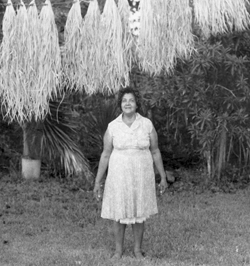
Another form of weaving that has been carried on by some Acadians utilizes latagnier or palmetto. This craft was probably learned from local Indians-and is still carried on among Houmas living in Terrebonne Parish, The best known Acadian palmetto weaver is Elvina Kidder of Arnaudville, who makes baskets, fans, pocketbooks and hats among other artifacts. Miss Kidder "began learning palmetto braiding from her mother and sisters when she was five years old" (LeBlanc 1982:10). Although she began by making the traditional wide-brimmed men's hats and boy's dress hats, she later moved on to duplicate the high style of the day in many of the women's hats and accessories she made. She also utilized the sewing machine to join her tight fine weave together in a variety of creations. Thus, Miss Kidder represents a transition in the folk process from traditional materials, methods and artifacts to newer processes and designs. In part her marketing interest was piqued by the Acadian Handicrafts Project. Project Director Louise Olivier made frequent visits to Miss Kidder and her sister Alida Durio, as well as to Gladys Clark, who also participated. They were especially encouraged to make and sell their more traditional items. A number of Miss Kidder's works from the project are in collections at LSU and the State Museum.
Lace and Needlework
Because they have often been associated with opulence and luxury, lace and embroidery may seem out of place in a consideration of traditional crafts. But exquisite laces and embroideries which from about 1500 on adorned the costumes of the rich and also vestments and altar cloths of the church were, after all, largely the work of anonymous artisans. And these domestic decorative arts have been preserved in our own time largely as the work, of women, who practice them as a means of creative expression and as a way of embellishing their homes or their clothing. Many of the items which are made by hand or decorated with handiwork today are produced for special occasions (christenings, weddings, burials), the special nature of the occasion being emphasized by the elaborate display of skilled handwork. Moreover, many women learned their needlework skills and the specific patterns they use from members of their communities, and learning to do needlework was generally considered an ordinary part of becoming a woman in their communities.
For example, the Louisiana Traditional Crafts exhibition at LSU in 1980 included crocheted doilies made by Minnie Lee Graves of Hico Community near Dubach. Mrs. Graves learned to crochet from a high school friend. About age fourteen at the time, Mrs. Graves was intrigued watching her friend sitting under the pine trees crocheting during recess and the noon hour at school. Her friend, Vera Fowler (Herren), had learned to crochet from her mother, and she offered to teach Mrs. Graves. After first learning a chain stitch and then an edging and most other basics Mrs. Graves was eventually able to execute almost any piece of crochet. Neither Mrs. Graves nor Mrs Herren ever learned to crochet by using the written instructions often appearing in magazines and books; they could, however, like many other traditional craftspeople, reproduce any crocheted article they wished if they had the actual item to go by.
Mrs. Graves has doilies scattered throughout her home-on top of chests and tables, under lamps, and hanging from shelves in her china cabinet. She has also crocheted larger items, notably two bedspreads which she has recently given to two great-nieces; but neuritis in her hand now prevents her from doing any more crochet.
A great number of women still crochet today, although a growing number of them learned with the aid of instruction books and use commercial patterns. It is common, however, even for those using books to seek the aid of an accomplished craftswoman when attempting to learn an especially difficult stitch.
Like crocheting, tatting is a needle art still practiced in north Louisiana, although its practitioners are considerably fewer than those who do crocheting. Although tatting can also be learned with printed instructions, it is most frequently learned by observation and individual tutoring since it is quite difficult. In south Louisiana Theresa Hughes of Lafayette learned tatting as a young girl from her brother-in-law's niece, Delia Broussard. After her marriage in 1931, Mrs. Hughes spent fifteen years travelling with her husband, whose job maintaining and repairing locks and safes involved calling on businesses all over the south. During those years of travel, Mrs. Hughes sat in the car and did tatting while her husband made his business calls. She sells her work and she reports that there has always been a demand for it more in fact than she can keep up with. Besides baby bonnets and booties, Mrs. Hughes makes lace-edged handkerchiefs which the owner of a local fashion shop buys from her, and satin garters which she decorates with tatted lace are a popular graduation present for young women, who supposedly later wear them to be married in.
Mrs. Hughes has tried a number of times to teach her craft to others, but without success. She has concluded, in fact, that it is too difficult to be readily taught. As the stitches in tatting are formed over the fingers, and the only equipment is a small shuttle which merely carries the thread the exquisite forms do seem to materialize by magic at the flick of the tatter's fingers. Mrs. Hughes owns several instructional booklets which she has accumulated over the years, and from these she has added patterns to her repertoire, although she copies them by looking at the patterns rather than by following the instructions. She likes patterns which are "tight," and she also feels that people like her work because it is "tightly made" and will hold up after being laundered, unlike the tatting of people who may in fact work faster. It takes Mrs. Hughes about a week to make a baby bonnet. She prefers cotton thread. She has made booties of rayon thread, but finds rayon harder to work with and not as satisfactory in terms of holding up after laundering.
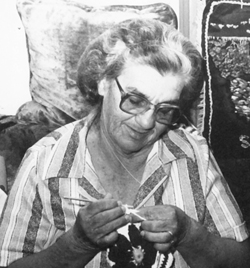
Perhaps one of the most overlooked lacework tradition in Louisiana is that carried on by a few women of Isleños, or Canary Island Spanish, descent in St. Bernard Parish. A wide variety of cotton crochet items generally referred to by the term paño are made by Mrs. Martin Alfonso of Delacroix Island and other persons there and at Yscloskey. Paños, generally made of white cotton thread in tight symmetrical patterns, are used as bed covers (paño de cama), table covers (paño de mesa) or small shelf display items (pañonitos). Balanced against the white body of most paños are intense colors of red, blue or green. Such colors and the style of the lacework are similar to that still found in the Canary Islands and southern Spain.
Women in the more recently settled Latin American communities in New Orleans also brought with them a wide variety of needlework skills which formed part of every young woman's education. Spanish nuns in Latin America, in turn, are probably responsible for some uniform features of the handwork, as well as for passing on to their pupils a tradition of fine workmanship. For example, Maria Marenco makes such items as pillowcases by the technique of drawnwork, a technique common in Latin American handicrafts but little known in the United States. Other Latin needlewomen, such as Etelvina de Vaides and Rosa Cardona, make beautiful garments such as baptismal dresses or garments for other ceremonial occasions; Mrs. Cardona has taken to doing embroidery for Mardi Gras gowns, for example (de Caro and Jordan 1980:27-28).
All Saint's Day Wreaths and Other Ritual-Festival Craft Items
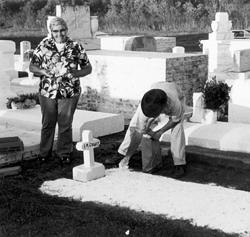
Emma Gaither of Maringouin and Theresa Mouton of St. Martinville represent a tradition which was at one time more widespread in south Louisiana. They make wreaths which have ritual uses in local communities. These wreaths are made principally for All Saints' Day (November 1), which is, in Louisiana and Mediterranean-derived Catholic areas in general such as the Hispanic-American Southwest and Mexico, a day for remembering deceased relatives and friends. Cemeteries are visited, tombs are whitewashed (or, more likely today, coated with latex-based paint), and flowers are put on graves. In Mexico a great many folk artifacts associated with the "Days of the Dead" are manufactured, and in Louisiana there has been a tradition of making artificial wreaths and flowers for graves. Beaded mourning wreaths were used in New Orleans and in St. Tammany Parish, and the Petit Paris Museum in St. Martinville has an example of a tin wreath. Wreaths such as Mrs. Mouton makes, using crepe paper flowers dipped in wax, were at one time common in St. Martinville. Twenty years ago it was usual to see black women selling such wreaths on the square before St. Martin of Tours Church of All Saints' Day morning, wreaths which were then carried for their own and family use.
Though the ritual traditions of All Saints' Day continue to be strong in Louisiana, there has been a major shift away from handmade artificial wreaths to other decorative forms such as mass-produced plastic flowers. Yet since the tradition points to eternal life of the souls who rise from Purgatory and the Saints already in Heaven by way of unwilting artificial flowers-plastic or otherwise-the belief and associated aesthetic seems consistent, though the crafts tradition has largely withered. Mrs. Mouton, who believes she is the last person in St. Martinville who makes such wreaths, which she sells to local residents comments, "My flowers don't cry (melt) in the sun or rain." Reportedly, the handmade artificial wreaths are still used more extensively on the Cajun prairies to the west.
Mrs. Mouton's wreaths, which are referred to as "crowns" in St. Martinville (from the French "couronne," a name by which the wreaths are still known in Basile), are made of wire, crepe paper, and wax. The flowers are shaped out of the paper, and thin wire is used to attach them to a circle of thicker wire (generally a coat hanger). Green paper suggestive of a stem is used to cover the wire, and the creation is dipped in wax to stiffen the flowers and to provide protection against the elements. Mrs. Mouton does not recall precisely who taught her to construct wreaths when she was a child, except to credit older relatives in a day when many knew how to make the crowns.
Mrs. Gaither's wreaths are different but also simply made. She too learned to make them from a family member as a child over sixty years ago. She starts with a coat hanger shaped into a circle and covers this with wads of newspaper, which are tied on with strips of cloth. Previously cut strips of crepe paper are wound around the inner padding. She does not wax the wreaths, and so they deteriorate fairly quickly (in the past, wreaths in the St. Martinville area were not always waxed either). She notes that she has made wreaths using, instead of crepe paper, strips cut from plastic trash bags, which are impervious to the weather. Mrs. Gaither makes the wreaths for friends, who bring her the materials, and for her own family. In 1979, she made about forty wreaths. She is proud that she has never let a year go by (since she took over the responsibility from her mother) without honoring her dead relatives by making wreaths for their graves. What is particularly interesting about the ritual tradition in which Mrs. Gaither participates is that the placing of the wreaths takes place in the cemetery of the Sweet Home Baptist Church. Although All Saints' Day is historically a Catholic celebration, it is also, for Louisi, an occasion for the affirmation of family ties and of the continuity of the family through time. That Baptists in Maringouin have chosen All Saints' Day as the time for their commemorative ceremonies is an interesting example of one religion's borrowing from another.
A variety of other religious activities in Louisiana have a craft aspect, though often not as a defining feature. Home altars and shadow boxes found in Catholic homes in French Louisiana are creative assemblages of sacred materials. Much the same could be said for St. Joseph altars, though they are not crafts in the usual sense of the word. They are, however, traditional material aesthetic forms in a ritual context. Perhaps a stronger case can be made for the craft aspects of the St. Joseph breads which are molded into a variety of intricate sacred forms (see photograph accompanying article this section by Gutierrez). Although some church, yard and roadside stations-of-the-cross icons were at one time carved from wood, this tradition does not persist in French Louisiana. More research may, however, turn up Santo (saint) makers among recent Latin immigrants.
Kindred to some extent to the wreaths described above are tombstones and other grave markers made at home or by local craftspersons. Within the French tradition are the intricate metal crosses found in many Louisiana cemeteries, which feature fleurs-de-lis and hearts, among other shapes. Such items were originally made by blacksmiths, but they are not made regularly today except as a demonstration of a traditional skill.
Just as craft items are associated with rituals, so too are they a part of festivals. This is particularly true with regard to Mardi Gras. Traditional costumes run the gamut from the dazzling bead-and-feather creations of the Mardi Gras Indians in New Orleans to the simply sewn rag-tag outfits of some Cajun and rural Creole Mardi Gras clowns. A great deal of time and energy, not to mention money, is put into the costumes of New Orleans Mardi Gras Indians. Costume makers such as prizewinning twenty-seven-year-old Charles Taylor of New Orleans wear their costumes only once before tearing them down and reusing the beads to make outfits for other people or their children. His costumes generally do not use any complete pieces of earlier costumes. Thus, an apparent Afro-Caribbean aesthetic of improvising in the making of new costumes comes into play, whereby old parts are disassembled and then reassembled in interesting new ways.
Many people make Mardi Gras costumes without a specific cultural tradition in mind. Many, of course, also simply buy costumes. The same is true with most of the floats in parades, with at least one exception. The Barth family of New Orleans has made papier-maché Mardi Gras floats and masks for four generations. Joseph Barth, III comments, "Our Mardi Gras floats are the only ones that are individually made of papier-maché. The other floats made by the big producers are made from molds and they aren't even made here. My father is always saying it just isn't right that every float has the same face and the same pair of hands " (Tobar-Blanco, Perry, Harker, and Panquerne 1978:22).
Musical Instruments
Folk instrument making is a craft currently thriving in Louisiana along with a resurgence of interest in traditional music and culture. Nowhere is this more evident than in south Louisiana, where sixteen accordion makers are currently active (Map). The accordion was patented in Vienna in 1829 and did not arrive in Louisiana until the 1880s (Comeaux 1978:118). It is thought by some that the instrument was introduced by German settlers from the Midwest, but it was also made available through retail outlet merchants. Definitive research on how the accordion became the centerpiece of twentieth-century Cajun music has not been carried out, but it does appear that local manufacture of the instrument did not begin until it became more difficult to get the German models, such as Hohner and Monarch, during World War II (Comeaux 1978:112). Necessity then spawned local creation of what some humorously called "le Abbeville air compressor." Comeaux says:
Broken accordions had to be repaired, and several musicians from necessity took it upon themselves to repair them. Most did it only as a hobby in their spare time, but for a few it grew to be a business. These craftsmen became very good at repairing accordions, and they soon began making the entire instrument. Locally made accordions were quickly recognized as superior to the imported models, and an industry had begun. (1978:122)
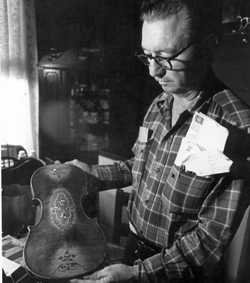
The leading proponent or accordions made in Louisiana is Mark Savoy of Eunice. Recognized as an instrument-builder throughout French-speaking North America and France, Savoy began ex-perimenting with accordions at an early age. Steeped in Cajun music and culture, but also the recipient of an engineering degree from LSU, Savoy has developed models of "Acadian Accor-dions" over the years as he has tried to make his instruments to the exacting standards of professional performers of traditional music from French Canada in particular (Savoy n.d.).
As a folk instrument, the violin has a longer history in Louisiana than the accordion. It is also easier to construct a simple violin out of such items as a gourd or cigar box-many old-time fiddlers made their first instrument out of a box wired with window screen to a knife-cut neck. The violin, unlike the accordion, is not associated exclusively with the French culture of south Louisiana. It has been played in hillbilly and, later, bluegrass music as well as Cajun music, blues and old-time jazz. While the total number of violin makers in Louisiana today has not yet been surveyed, a number of craftsmen are active. Perhaps the best known in French Louisiana is musician and historian Lionel Leleux from Leleux Community on the prairies northwest of Kaplan. His instruments, in addition to having a fine tone usually have a variety of pearl inlays to add to their luster. In north Louisiana, former Louisiana Hayride performer and current Shreveport resident Tex Grimsley is also known for his folk fiddles. There are surely others in the area, owing to the great popularity of the instrument, but north Louisiana music traditions are just beginning to be researched. Other south Louisiana makers include Cajuns Adner Ortego of Washington and Royne Fontenot of Eunice. Cigar-box violins are not constructed today except as demonstrations of the roots of a particular person's playing ability. Joseph "BeBe" Carriere, an older Creole man from Lawtell, St. Landry Parish, was asked to construct such a violin for a research project on zydeco music. He made two models, one of which is in the Country Music Museum in Nashville, and the other of which is included in the exhibit "The Creole State."
No traditional guitar makers have been located in the state as of this writing, although a large number of craft revivalists make this instrument and others such as the dulcimer, banjo, and man-dolin. Of these, the mandolin is reported to have been made in a folk form out of turtle shells for musicians in the Marthaville area (H.F. Gregory, personal communication to NRS). Undoubtedly, basic homemade variants of the other instruments were made also, as was true elsewhere in the South.
Some instruments of African and Afro-American origin have been and are currently made in Louisiana, albeit in quite modified forms. Perhaps the best starting point for research on such items is in historical accounts of the gatherings of slaves in Place Congo in New Orleans, in which descriptions of the music often include mention of the drums. Another fascinating source is the Works Progress Administration's "Ex-Slave Narratives." From these, folklorist Robert B. Winans has shown the following references to instruments in Louisiana: fiddle (10); banjo (6); percussion (9); bones (3); guitar (1); accordion (2); jews harp (1); jawbones (1) and cow horn flute (1) (1980). Contemporary work with black music in Louisiana has not revealed home-crafted drums except where individuals use already formed objects such as oil drums and overturned waste baskets for percussion. However, there are bones players in the state, and at least one maker of bones for this use is Paul Duhon of Judice Community, west of Lafayette. Duhon learned how to play and make bones from black railroad workers. Folk music researcher David Evans has located one-string instruments, similar to some found in West Africa, in Washington Parish. One maker-player of the one-string mouth-bow (also called a "jawbone" and "diddley-bow") documented by Evans was the late Eli Owens of Bogalusa (Evans personal communication to NRS). Dr. Fred Kniffen has also reported seeing okra pod kazoos among blacks in south Louisiana.
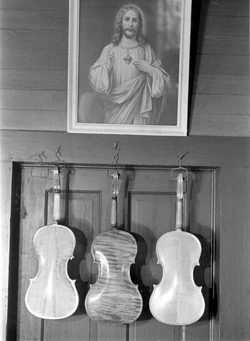
Perhaps the most unique contemporary folk instrument, played with an Afro-Caribbean aesthetic, is the frottoir found in Creole zydeco music. Although rhythmic scraping was probably once provided by notched sticks and animal jawbones, the washboard played with spoons became a mainstay of a variety of Southern musical forms, including zydeco in the twenties. Perhaps because the rubboard syncopation was so essential to zydeco, vest-hung frottoirs were developed later after the introduction of corrugated steel in Louisiana for house roofing and barn siding. A few south Louisiana tinsmiths and sheet-metal outfits make these instruments to order as a folk-cottage industry.
Certainly there is a vast difference in the degree of craftsmanship between that required to make an accordion or violin and many of the simple folk instruments like okra pods, bones, and frottoirs. Items such as Indian cane whistles and Indian-Anglo cow horns (for calling neighbors or hunting dogs) have not been touched upon, although they are still made. Their musicality is certainly less significant than their craftsmanship. As the revival of folk music tradition continues in Louisiana we are likely to see many more instrument makers of all degrees and kinds.
Cane Carving
Finding craft and other material items in the New World that are of African origin has long been an elusive search for students of folk tradition. In part the lack of definitive African roots for crafts is due to the conditions under which slaves came to America-lacking their tools and materials and uprooted from their traditions in general. Of course, many black craftsmen make artifacts such as quilts or split-oak baskets in apparent Anglo styles. On the other hand, the methods of construction and patterns used are often quite different. Thus some Afro-American crafts follow a pattern seen in a number of other creative traditions (such as music and storytelling) whereby improvisation and stylization take precedence over conservative faithfulness to a particular form. There are also some intriguing cases in the United States where apparent African material connections have been maintained (see Vlach 1978). In Louisiana, connections to African tradition are sometimes seen in quilt form, graveyard traditions, body art and foodways, among others. One apparent link is in the carving of walking sticks, carried on by at least two men in opposite-ends of the state. In Homer, David Allen has been making canes since around 1950. Using mostly hickory as a material, he carves various shapes on his canes: spirals, diamonds, or serpentine motifs. He may add rhinestones to create eyes for snakes or human faces! In New Orleans, Hugh "Daddy Boy" Williams creates more elaborate canes, many with erotic motifs that he calls "X-rated." Perhaps his most fascinating works include the African folktale about the "Signifyin' Monkey" as a motif. The monkey at the top of the stick is arguing with a tiger, snake and, perhaps as a Louisiana element, an alligator. The work of both carvers shows remarkable similarity to items found in parts of West Africa.
Walking sticks of rather different design are made by white carvers such as Eola oil-field worker Early Vidrine, who learned cane carving from his father. He carves his canes from dogwood or ash with a simple vine design which was inspired by a dogwood tree he saw wrapped with rattan vine (Minto and Bernard 1980:16). Basket maker Jack Phillips, from Shreveport, also carves walking sticks occasionally; however, he puts the design emphasis on the handle of the cane rather than the shaft. His canes usually exhibit elaborate faces such as snarling dogs, devils, or snakes. Unlike Vidrine's and Allen's canes, Phillips' canes are unvarnished, though he sometimes uses paint to highlight facial features of his creations.
Another Anglo carver was the late Ernest Cargle of Provencal (Gregory, Green and Raymond 1981:21). His intricate designs do not seem linked to a particular cultural style. Such highly individual carved forms are sometimes also called "tramp art" or "prison art" since they tend to show detailed repetitive designs made by those with time on their hands.
Folk Toys
In any society toys are needed to entertain children and provide an outlet for their play needs and fantasies. They may also serve as aids in education and acculturation (see also Soileau's essay on children's folklife in the previous section). There is a wide range of American folk toys, traditional play objects such as whirligigs, flap jacks, and whimmy diddles (Schnacke 1973). Louisiana shares in this larger American tradition. For example, Blake Owen of Pineville makes a wide variety of toys-wind toys, balance toys, spool tractors (a commercial thread spool is powered by a rubber band to run along the floor), switchblades (a rubber band and a clothespin are the mechanism which activate a harmless wooden "blade" in imitation of more deadly knives), pecking chickens (a weight hanging from a string is jiggled, and this motion causes an attached wooden chicken to rock back and forth as though pecking), and others. Owen learned woodworking techniques from his father, though he did not start on toys until recently when, in the late 1960s, his children grown, he rediscovered his father's tools and began to remember some of the toys of his own childhood. Fir is a favored wood for his toys (which may also incorporate metal parts) (Gregory, Green and Raymond 1981:20, 37-40).
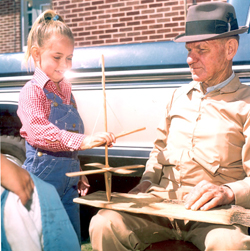
Toys may be one aspect of a larger crafts repertoire and Jack Phillips of Shreveport, who makes baskets and furniture, also makes toys, including puzzles and children's chairs. Other toys may mirror aspects of Louisiana folklife in providing miniature "models" of adult activities. Ira W. Sandel of Plainview grew up in a lumbering community at a time when logs were still hauled by oxen-pulled wagons. He started whittling a few years ago for his grandchildren and today makes miniature representations of those log wagons of cedar, hickory, sweet gum, leather, and metal. Pete Gregory, raised in Concordia Parish in the Delta region of the state, grandson of a boatbuilder and fisherman, remembers being given a toy bateau. As a teenager, he learned to carve himself, and he has continued to use that knowledge to make toy folk boats for his children and those of neighbors. Gregory makes other kinds of toys as well (Gregory, Green and Raymond 1981:14, 11, 38, 41).
Cornshuck and apple dolls are widespread in rural areas of the United States and seem to spring from independent invention everywhere as well as from the influence of national craft magazines (i.e., it is not a folk process of learning). A number of cornshuck-doll makers are found throughout Louisiana, from Chauvin and Duson in the south to Pineville and Ruston in the north. Geraldine Robertson of Opelousas makes cornshuck dolls as she learned as a girl. Her dolls, which she has sold in folk festivals, range in size from four to eight inches tall, have yarn hair, and are usually dressed in calico skirts. Along with the individual dolls, she has begun to create nativity scenes featuring animals and angels with the Biblical characters. These scenes incorporate modern materials also, such as straw flowers, yarn, and colored ribbon.
Traditional Crafts: The Future
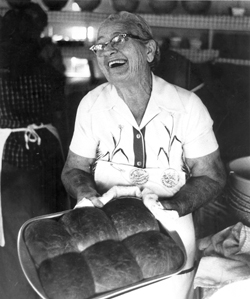
Louisiana crafts are becoming more recognized here and elsewhere as tangible links to the traditions of the many groups in the state. They are at the same time becoming symbols for the future of hand skills and traditional ideas. In this process crafts may change greatly in form and function. For example, when an item such as a basket or quilt becomes popular on the market, its cost goes up and it may become and "art form" in the eyes of the buyer as well as the seller. This is not necessarily regrettable since crafts sales can generate income for rural people while putting outsiders more in touch with local traditions. The negative effect can be that commercialization will lead to the lowering of quality, the loss of traditional significance in a community and a smug assurance on the part of the buyer that he or she is somehow really supporting the traditional community. Complex questions on the place of traditional crafts in festival and commercial settings are rarely asked by festival presenters, craftspeople, or consumers. Certain items seem destined to remain fairly traditional because of their sheer practicality. Such is probably true of tool handles, which will never be big sellers as "artistic" items. Quilts seem to function well in both worlds. Quilters can quilt for the home and hearth as well as for the buying public. Quilts "work" as abstract art to some and as bed cover and a symbol of family ties (e.g., the "Double Wedding Ring") for others. Duck decoys seem especially well suited to exist in at least two settings: on the marsh (working decoy) or on the mantel piece (art decoy).
One factor clearly in favor of the continuing vitality of traditional crafts in the state is the infusion of new ethic groups. Latin Americans-Cubans, Hondurans, Nicaraguans among others-have become an important presence in New Orleans over the last two decades and have brought with them not only needlework traditions and their own tradition of All Saints wreaths but no doubt other crafts of which we are not yet aware. There is even a Honduran hammock maker in New Orleans, Maria Luisa Winberger, a native of San Pedro Sula, Honduras, who came to New Orleans in 1951. She learned to make hammocks in Honduras from an Indian woman from the Mosquito Coast region, a traveling vendor of fabrics who also taught hammock making as a way of promoting sales of her wares. She sells those hammocks which she makes today and has appeared at the Jazz and Heritage Festival. The Vietnamese are even more newly arrived; their crafts include nets, boats, paper lanterns, musical instruments, traditional clothing, altar cloths, and banners (de Caro and Jordan 1980:28, 30-31).
As traditional handmade items are increasingly in the public eye through festivals, co-ops, and cottage industry production, it will be interesting to see how Louisiana's many craft traditions change-and remain the same-in the future.
Bibliography
Black, Patti Carr, et al. Made by Hand: Mississippi Folk Art. Mississippi Department of Archives and History. Jackson, Mississippi, 1980.
Chittenden, Varick and Gerry Parsons. "Utility Craft to Fine Art: Changes in Decoy Carving." National Folk Festival Program Guide. National Council for Traditional Arts, Washington, D. C. 1980.
Christian, Marcus. Negro Iron Workers of Louisiana, 1718-1900. Pelican, 1972.
Comeaux, Malcolm L. Atchafalaya Swamp Life: Settlement and Folk Occupations. Geoscience and Man 2, Museum of Geoscience, Louisiana State University, Baton Rouge, 1972.
_____. "The Cajun Accordion." Louisiana Review. 7(1978):117-128.
de Caro, F. A. and R. A. Jordan. Louisiana Traditional Crafts. Louisiana State University Union, Baton Rouge, 1980.
Edwards, Jim Buckhannon and Jorenda Stone. Homespun Heritage: A Collection of Folkways and Other Hand-Me Downs. Columbia Art and Folk Festival, Columbia, Louisiana, 1977.
Frank, Charles. Louisiana Duck Decoys. Pelican, New Orleans, 1975.
Gregory, Hiram F. Jr. "The Black River Commercial Fisheries: A Study in Cultural Geography." Louisiana Studies. 5(1966):3-36.
Gregory, H. F., Melissa Green, and Douglas Raymond. Doing It Right and Passing It On: North Louisiana Crafts. Alexandria Museum/Visual Art Center, Alexandria, 1981.
Johnsgard, Paul A., ed. The Bird Decoy: An American Art Form. University of Nebraska Press, Lincoln, 1976.
Kniffen, Fred B. and Malcolm L. Comeaux. "The Spanish Moss Folk Industry of Louisiana." Melanges 12. Museum of Geoscience, Louisiana State University, Baton Rouge, 1979.
LeBlanc, Jennifer Fortier. Acadian Palmetto Braiding: The Folk Art of Elvina Kidder. Lafayette Natural History Museum, Lafayette, 1982.
Minton, Karen and Elaine Bernard. "Raisin' Canes." Rapides Revue. 2(4)(1980):16-17.
Post, Lauren C. Cajun Sketches from the Prairies of Southwest Louisiana. Louisiana State University Press, Baton Rouge, 1962.
Roach-Lankford, Susan. Patchwork Quilts: Deep South Traditions. Alexandria Museum, Alexandria, 1980.
_____. Gifts from the Hills: North Central Louisiana Folk Traditions. North Central Louisiana Folklife Project, Louisiana Tech., Ruston, 1984.
Savoy, Mark. Unpublished manuscript on the accordion. n.d.
Schnacke, Dick. American Folk Toys: How to Make Them. Penguin, Baltimore, 1973.
Tobar-Blanco, Ruby, Sandy Perry, Bruce Harker, and Don Panquerne, eds. Louisiana Hands. Southern Arts and Crafts Foundation, New Orleans, 1978.
Vlach, John Michael. The Afro-American Tradition in Decorative Arts. Cleveland Museum of Art, Cleveland, 1978.
Winans, Robert B, "References to Musical Instruments in the WPA Ex-Slave Narratives."Paper Presented at the meetings of the American Folklore Society, Los Angeles, 1980.
Workman, J ay. "Blacksmith forges life out of a dying trade." Baton Rouge Sunday Advocate. September 19, 1982, 4-B.


